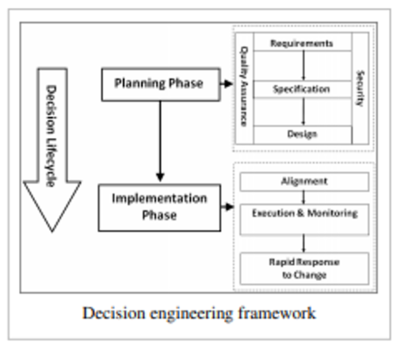Decision Engineering
Decision Engineering is a framework that unifies a number of best practices for organizational decision-making. It is based on the recognition that, in many organizations, decision-making could be improved if a more structured approach were used. Decision engineering seeks to overcome a decision-making "complexity ceiling", which is characterized by a mismatch between the sophistication of organizational decision-making practices and the complexity of situations in which those decisions must be made. As such, it seeks to solve some of the issues identified around complexity theory and organizations.[1]
It is interesting to note that, despite decades of development of decision support systems and methodologies (like decision analysis), these are still less popular than spreadsheets as primary tools for decision-making. Decision engineering seeks to bridge this gap, creating a critical mass of users of a common methodology and language for the core entities included in a decision, such as assumptions, external values, facts, data, and conclusions. If a pattern from previous industries holds, such a methodology will also facilitate technology adoption, by clarifying common maturity models and road maps that can be shared from one organization to another. The decision engineering approach is multidisciplinary, unifying findings on cognitive bias and decision-making, situational awareness, critical and creative thinking, collaboration, and organizational design, with engineering technologies. Decision engineering is considered an improvement upon current organizational decision-making practices, which include the use of spreadsheets (difficult to QA, hard to collaborate and discuss), text (sequential in nature, so is not a good fit for how information flows through a decision structure), and verbal argument. The movement from these largely informal structures to one in which a decision is documented in a well-understood, visual language, echoes the creation of common blueprint methodologies in construction, with the promise of similar benefits.
Decision engineering is both a very new and also a very old discipline. Many of its elements—such as the language of assessing assumptions, using logic to support an argument, the necessity of critical thinking to evaluate a decision, and understanding the impacts of bias — are ancient. Yet the realization that these elements can form a coherent whole that provides significant benefits to organizations by focusing on a common methodology is relatively new.
See Also

